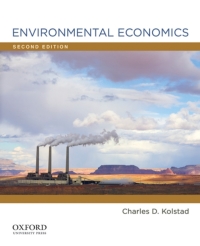Two types of consumers (workers and retirees) share a community with a polluting cheese factory. The pollution
Question:
Two types of consumers (workers and retirees) share a community with a polluting cheese factory. The pollution is nonrival and nonexcludable. The total damage to workers is \(p^{2}\) where \(p\) is the amount of pollution and the total damage to retirees is \(3 p^{2}\). Thus marginal damage to workers is \(2 p\) and marginal damage to retirees is \(6 p\). According to an analysis by consulting engineers, the cheese factory saves \(20 p-p^{2}\) by polluting \(p\), for a marginal savings of \(20-2 p\).
a. Find the aggregate (including both types of consumers) marginal damage for the public bad.
b. Graph the marginal savings and aggregate marginal damage curves with pollution on the horizontal axis.
c. How much will the cheese factory pollute in the absence of any regulation or bargaining? What is this society's optimal level of pollution?
d. Starting from the uncontrolled level of pollution calculated in part (c), find the marginal willingness to pay for pollution abatement, \(A\), for each consumer class. (Abatement is reduction is pollution; zero abatement would be associated with the uncontrolled level of pollution.) Find the aggregate marginal willingness to pay for abatement.
e. Again starting from the uncontrolled level of pollution, what is the firm's marginal cost of pollution abatement? What is the optimal level of \(A\) ?
f. Are the problems of optimal provision of the public bad (pollution) and the public good (abatement) equivalent? Explain why or why not.
Step by Step Answer:





